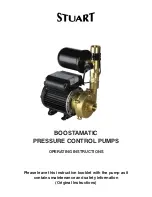
SPEED CONTROL SCHEMATIC DIAGRAMS: (cont.)
Example 4: Switch to Power Speed Changing
When the switching action is in reverse to what can be used as shown Example 3, such as some pressure
switches, the action can be reversed using
a Single Pole Dual Throw (SPDT) relay as
shown to the right. Current draw through
this circuit is extremely low (much less than
1 amp), so a very low current rating for this
relay and switch can be used. Use the
diagram to the right as a guide to properly
wire this example. Reduced speed is
recommended during long periods of low
engine fuel demand conditions to avoid fuel
system heat build-up.
Example 5: Variable Speed
Devices such as an aftermarket ECM can create a pulsed signal (“pulling” voltage to ground at a given frequency).
This signal has a characteristic of dwell time, which is a ratio of on-time vs. off-time (in other words, the amount of
time the signal is “high” vs. “low”). This difference in dwell time percentage will enable the fuel pump to operate at
various speeds or flow rate. A graph demonstrating an example signal created by such a device is shown below.
The example signal is at 66% duty cycle, whereas the amount time that the signal is above 1.65V voltage is about
twice the amount of time at zero volts. When duty cycle is between 5%-20%, the fuel pump is turned off. A duty
cycle between 20%-90% will be variable speed between Minimum and Maximum Speeds, while duty cycles of 90%-
100% are at Full Speed. Frequency range is allowed between 100Hz and 5000Hz. “High” voltage may be as high
as the vehicle’s voltage.
This Fuel Pump is not compatible for use with the Fuelab Electronic Fuel Pressure Regulator per Models 52901
and 52902, that creates its own pulsed signal. Refer to instructions for Electronic Regulator that may be compatible
for proper wiring and installation.
Installation Steps:
1. Disconnect the ground terminal from battery and allow the vehicle’s engine and exhaust system to cool. Relieve
fuel system pressure per applicable service manual. Follow all Warnings, Cautions and Instructions written on
previous pages of these instructions.
2. Modify, remove or replace other fuel system components as required per established build plan (reference notes
on previous pages and above).
3. Remove the fuel tank or cell from the vehicle, noting all precautions regarding fuel vapors being
EXPLOSIVE
on
the first page herein (if applicable). Installer is responsible for all fabrication necessary to mount and seal the fuel
pump to fuel cell or fuel tank. Installer is also responsible for securing inlet straining filter (not supplied) to -8AN
inlet.
4. Install the fuel fittings (not supplied). The threads used on these fuel ports are not tapered or pipe threads. Do not
use Teflon
thread tape or thread sealant on these threads, as this can cause leakage or introduce debris into the
fuel system. Fittings to be used with these style of ports require use of the enclosed -908 o-rings for proper
sealing. Use light oil to lubricate the o-rings just prior to installation. Install the O-rings onto the fuel fitting first.
Position the o-ring in the thread relief of the fitting. Thread fitting into fuel pump and tighten between 5 and 15
ft
ꞏ
lbs of torque.
ALL
fuel line that is internal to tank
MUST
be fuel compatible both inside and outside of the line.
PTFE based fuel line is recommended for a long service life.
5. Upon installation of fuel tank or cell and installation of all other fuel system components, Inspect fuel system for
any contact of fuel lines or wires with other components that can cause chafing or rubbing. Secure all components
and fuel lines. Ensure that moving components of vehicle are clear.
6. Connect the vehicle’s battery. Perform initial priming: The fuel pump may require priming during initial operation
and for moment after depletion of fuel from fuel tank or cell. This action can be accomplished by removing fuel line
110021026-1, Rev A Sheet 4 of 6
AT REDUCED SPEED
SPDT RELAY
NO
NC
SHOWN (OPEN).
WITH SWITCH POSITION
(1+A Rating)
C
PUMP OPERATES
FROM
FUSED
SOURCE
(shown right):
Voltage (v)
* 0 to 3.3 Volts
* Freq. = 1000Hz
* Dwell Time = 66%
Example Square Wave,
-3
Time (sec X10 )
4
2
0
4
3
2
1
0
Input Signal
Electronic Device,
such as Aftermarket
Engine Control Unit
(Oscilloscope-like
displayshown,
representing incoming
speed control signal).
























